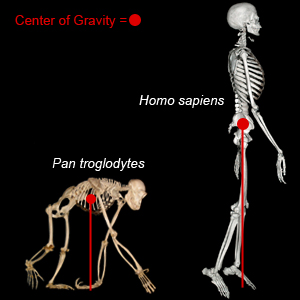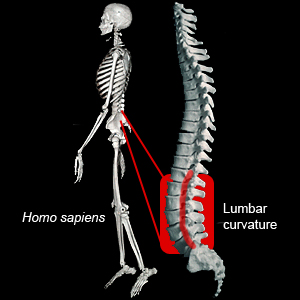Maintaining balance is critical when walking on two legs. In part of the walking cycle, a biped must balance on one leg while lifting the other foot off the ground and swinging it forward. In most quadrupedal hominins, the center of gravity is located near center on the torso. In modern humans, the center of gravity is closer to the center of the pelvis. As the legs alternate swinging forward during the walking cycle, the center of gravity shifts from one side of the pelvis to the other, making a pattern similar to the figure 8. The lumbar curvature on the spine helps to bring the center of gravity closer to the body’s midline and above the feet.
The number and size of the lumbar vertebrae in humans is different than in apes. Humans usually have 5 comparatively larger lumbar vertebrae. Most large apes typically have 4 lumbar vertebrae that are relatively smaller than human lumbar vertebrae. The greater number and size of the vertebrae forms a more flexible lower back that permits the hips and trunk to swivel forward when walking. Because the ape lower back is less flexible, the hips must shift a greater distance forward with each step when an ape walks bipedally.
Australopithecus lumbar vertebral bodies were broad for effective weight transmission from the upper body to the pelvis. Australopiths had 5 or 6 lumbar vertebrae that articulated to form a distinctive lumbar curvature, similar to the morphology of modern humans8,9,15.
 |
 |
|
Estimated center of gravity in modern humans and extant chimpanzees. |
The lumbar curvature (shown in the red box) permits the hipds and tunk to swivel forward during walking. |
eFossils is a collaborative website in which users can explore important fossil localities and browse the fossil digital library. If you have any problems using this site or have any other questions, please feel free to contact us.
Funding for eFossils was provided by the Longhorn Innovation Fund for Technology (LIFT) Award from the Research & Educational Technology Committee (R&E) of the IT governance structure at The University of Texas at Austin.
